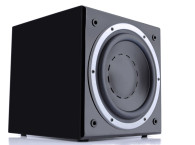This fall, Klippel GmbH will celebrate its 25th anniversary and that will provide a good reason to revisit interesting and less known stories from the company, including its path toward the Klippel Controlled Sound (KCS) that is now starting to get recognition. The extensive published research and the implications on the speaker industry for much of Klippel's work deserve to be revisited. But there's also a lot more history on amplifier protection circuits and why they became important in transistor designs.

Direct coupled amps that were transformer-less without coupling caps could lead to burning out the speakers if the amplifier had a meltdown – especially in the earlier generations of high-power and switching-mode amplifiers. Most protection circuits were really about protecting the amplifier, not the speakers. Some protection schemes even ended up chattering ultrasonically, frying the tweeters/compression drivers as they attempted to protect the amplifier's output stage from problematic speaker loads.
Conversely, smart speaker protection from being overdriven by the program signal is more about excursion limiting for the bass combined with voice coil thermal limiting in mid and high frequencies. Pioneers in these techniques were Meyer Sound and Apogee Sound in the early 1980s with their processor-controlled touring sound systems. These were closely matched controllers and speakers that not only stayed out of trouble in the field, but never distorted no matter how hard they were over driven. Standalone speaker management systems from dbx and others followed, but ideally the speaker and amplifier designers would work together for defining the boundaries in integrated solutions. The cost of these rackmount processors were in the range of $500 and up (affordable for pro audio applications...), depending on how many amplifier channels they could handle.
Smart amp integrated circuit chips with just about everything the professional speaker protection processors accomplished were introduced more than a decade ago, essentially designed for mobile phones, laptops, Bluetooth speakers, and TVs. Astonishing at the time, all this was combined in a chip along with a few watt amplifier – for less than a buck! Those chips have been trickling up the product development chain into more expensive "smart" home audio products - first with smart speakers intended to promote the ecosystem for voice assistants, and now with a large focus on soundbars and speakerphones.
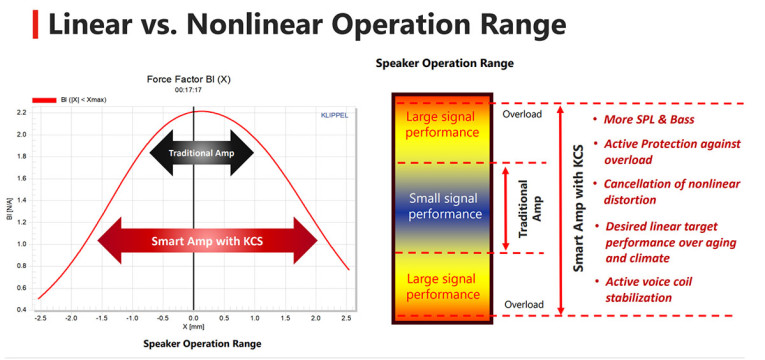
Advanced speaker protection processing can be a two-sided sword. We want to increase the maximum clean acoustic output without creating new failure modes by inadvertently crossing the line. Specifically, the concern is transducer fatigue issues by dancing at the edge with a high duty cycle (especially on ring tones), creating new fatigue failures that could cause smartphones to be returned by unhappy users (which Apple, Samsung, and Huawei, might find annoying).
NXP, Maxim, Texas Instruments, Cirrus Logic, Infineon, and Qualcomm have succeeded with their Smart Amps (sometimes also called "speaker amps"), all of which are a couple of watts - more than enough for smartphones, considering battery drain and what the speaker can handle. At this point smartphone speakers can play as loud as possible without rattling, buzzing, or most importantly without damage — allowing everyone in the business to sleep soundly.
I have always pressed the product managers at the Smart Amp companies to consider a version of this dynamic protection processing in a form that could be used from soundbars to subwoofers to concert sound to military hailing and civil defense voice warning systems. To further enable the expansion of Smart Amps is the prevailing trend of integration of the signal processing, amplifier, speakers and enclosures into finished products – not just smartphones, soundbars, subwoofers, but also self-powered pro sound speakers and automotive sound OEM. Closed systems enable close-coupled protection to do its job effectively.
But what more could speaker system designers want? How about where this article started: not just to protect the speaker from overload, but enable the speaker to play louder with reduced bass distortion. For functionality, aside from saving the speakers from damage, how about we drop distortion? And for applications where there are full-duplex signal paths with acoustic echo cancelers, add graceful barge-in, providing significantly wider gain margins before echoes?

Here we are, over a quarter of a century after Dr. Klippel’s patent, and feed-forward distortion nulling protection circuits are practical and in mass production. In 2020, Nuvoton Technology Corp., a Taiwan-based semiconductor maker unveiled a collaboration with Klippel and announced the world’s first smart amplifier with integrated Klippel Controlled Sound (KCS) technology and nonlinear speaker control algorithm. The Nuvoton NAU83G10 device can deliver up to 8W output power into a 4 ohm load and 6.5W for 8 ohms using a highly efficient boost converter. The NAU83G20 device can deliver up to 20W for 4 ohms and 11W for 8 ohms around 12.6V external battery supply levels.
The Nuvoton KCS audio amplifier chips have now entered mass production and are a versatile solution to improve speaker performance and sound quality by compensating for speaker nonlinearities. Correction is dynamic, and the higher the excursion the distortion nulling dramatically keeps the sound clean.
As I found with some recent projects, KCS actually delivers. I cannot talk about ongoing product developments that so impressed me (some won’t be shipping until long after this is published) but let’s just say I am a believer. KCS increases what a system designer can demand from smart speakers, Bluetooth speakers, OEM autosound, soundbars, conferencing, or huddle room voice lift, and eventually concert sound speakers.
What we can talk about here is about Nuvoton’s Smart Amps, which are already in Dell’s latest collaboration products. These are their mini-conferencing soundbars, SB522A and SP3022, which are in mass production, available online and in stores, and have been generating enthusiasm and impressed the first YouTube reviewers who got to try them out. I don't make my conversations available on YouTube, but I've been playing with my samples and I'm also impressed.
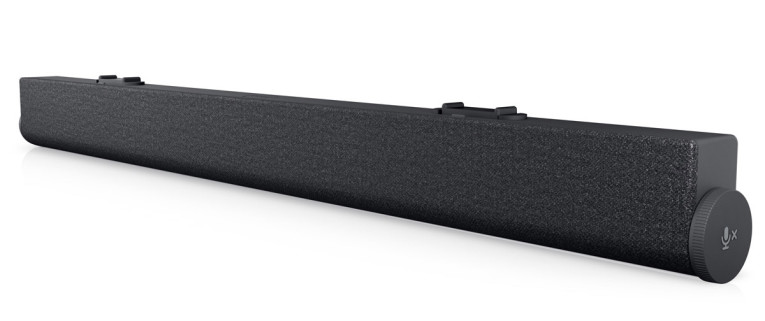
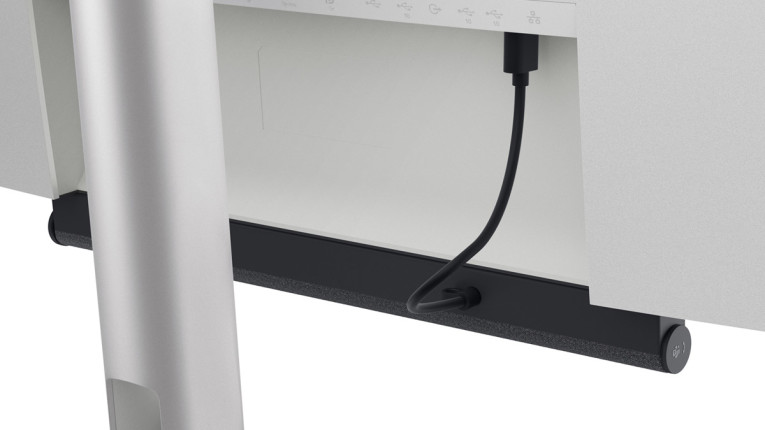
The Dell Slim Conferencing Soundbar (SB522A) is a descendant of Dell’s popular monitor-mounted soundbars. This micro-soundbar attaches magnetically to the bottom of a compatible Dell P- or UltraSharp-series monitors, via a 6” integrated USB-A cable with a built-in USB-C adapter (so no separate power supply). It features a built-in omni microphone with AI-powered noise and echo cancellation and support for full-duplex audio (so you can sing a duet with the other line).
In terms of design, the Slim Soundbar is compact at 11.6” wide, 0.7” in deep, and 1.1” high containing two microspeakers. For Windows, the Dell Peripherals Manager app has a bass/treble booster. The app is also useful whenever you need to update the firmware for bug fixes or upgrade. For Macs you control volume, and summon Siri using the built-in microphone. My older back-up Lenovo laptop was having issues with echo cancellation and I was wondering if using the Dell baby soundbar would sidestep this – and I just plugged it in and selected it and there was a dramatic improvement on all fronts.
The bigger brother is the Dell Speakerphone SP3022 at 9" length, a bit less than 3" width and about 2 1/4" deep, featuring a more sophisticated design with five buttons on the (classy looking) front fabric grill. One button is for instant connection to Microsoft Teams, another to answer the call, along with volume up and down buttons and mic mute. It connects via the USB-A interface (with integrated USB-C port pass-through connector) to monitors, laptops, or desktops.
Both of these are powered by Nuvoton’s KCS series 20 watt at 4 ohm version (NAU83G20), which has full Smart Amp protection with battery tracking automatic level control and brownout prevention and boost converter. I'm also exploring, for lower power, the 8 watt at 4 ohm version (NAU83G10) for other projects. Beta sampling in the fall is the more powerful and sophisticated NAU83G60, offering 2x 30 watts at 4 ohm (or 60W bridged) along with 15 band parametric EQ and three channels of DRC (digital room correction) along with low latency hooks for active noise canceling.


Besides lower distortion, increased AEC stability, speaker protection, along with increasing maximum acoustic output, Dr. Klippel has a path using KCS design techniques to reduce speaker materials and BOM. Through deeper system integration in the speaker design itself, that path is described as “Green Speaker Design.”
As we have touched upon here, KCS is an adaptive nonlinear control processing providing distortion reduction, voice coil stabilization, automatic alignment, and protection from mechanical and thermal overload for loudspeakers, headphones, and other actuators. These software features realized by DSP give us new opportunities in the design of the passive components (e.g., transducers and enclosures) for increasing efficiency and voltage sensitivity, which is the key for getting more acoustical output at higher quality from smaller speakers.
To help speaker engineers navigate their entry to Green Speaker Design, it is best to start with a careful read of Application Note AN 82 titled "Optimizing Transducer Design for Klippel Controlled Sound".
This application note discusses not only new ways to overcome physical limitations in traditional speaker design but also addresses other critical hardware problems (Rub & Buzz, endurance, and fatigue) that cannot be fixed by DSP but have to be solved by a hardware design and process control in manufacturing.
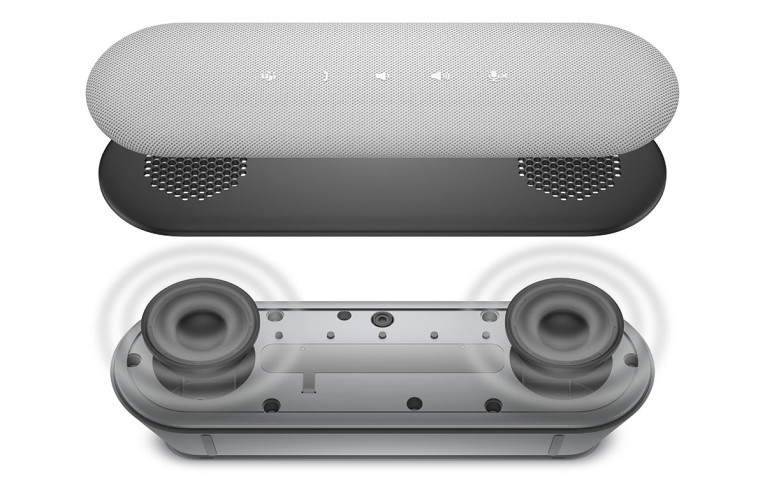
The compensation of Kms(x) usually comes with higher amplifier requirements, especially when driving the speaker below its natural fs where the stiffness is dominant. A nonlinear motor can give us the benefit of a higher pass-band sensitivity due to a lower moving mass (when comparing to overhang configurations). A nonlinear stiffness doesn’t give a performance benefit. One of the reasons to use a nonlinear (progressive) stiffness, is usually to introduce some kind of mechanical protection to avoid over-excursion. Due to the KCS reliability and more accurate nonlinear modeling protection system, amplification requirements are lower and highly optimized.
More case studies are in the works. Stay tuned.





